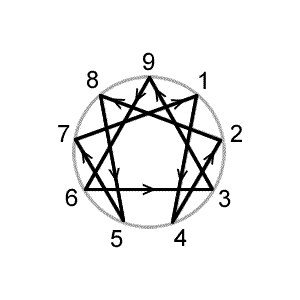Enneagram Stress and Growth / Security: Movement along the lines

Each Enneagram type is connected to two other types by way of the inner lines on the symbol. Two different movements are sometimes described when arrows are added to those lines.
Moving along a line away from type in the direction of the arrow is often described as a movement toward the stress point of a type. Moving against the arrow away from type is often described as a movement toward growth or security.
Although many schools of the Enneagram personality types use the inner lines to identify connecting points not all of those schools use the arrows.
The lines with the arrows
The two most prominent schools of the Enneagram personality types (The Narrative Enneagram and The Enneagram Institute) give meaning to the arrows.
The Narrative Enneagram describes movement with the arrow as toward a stress point while movement against the arrow is toward a security point.
From the narrativeenneagram.org website:
Security and stress points show where our energy and awareness flow, depending on our needs and circumstances. We often move from our “home base” to the two points connected to our own by the lines in the diagram. The stress point is where we go when feeling stressed and pressured, or when mobilizing for action. The security point is where we go when feeling relaxed or secure, or paradoxically, when feeling overwhelmed or exhausted. This dynamic movement creates a significant shift in our point of view and style of behavior, allowing us to become less stuck in our habitual patterns.
For example, type 1 in stress will go to type 4, but type 1 in security will go to type 7.
The Enneagram Institute describes movement with the arrow as the direction of disintegration (stress) and movement against the arrow as the direction of integration (growth).
From the enneagraminstitute.com website:
The inner lines of the Enneagram connect the types in a sequence that denotes what each type will do under different conditions. There are two lines connected to each type, and they connect with two other types. One line connects with a type that represents how a person of the first type behaves when they are moving toward health and growth. This is called the Direction of Integration or Growth. The other line goes to another type that represents how the person is likely to act out if they are under increased stress and pressure—when they feel they are not in control of the situation. This second line is called the Direction of Stress or Disintegration. In other words, different situations will evoke different kinds of responses from your personality. You will respond or adapt in different directions, as indicated by the lines of the Enneagram from your basic type.
For example, type 1 under stress will move in the direction of disintegration to type 4, but type 1 will move toward health and growth in the direction of integration to type 7.
Both approaches are similar but the directions of disintegration / integration also tie back to the levels of development.
The lines without the arrows
The reason the arrows are pointing as they do on the Enneagram symbol predates the personality types use of the symbol. The types simply used the arrows as they were without any additional rationale for why they mean what they mean.
In other words, you could just as easily make a case for the opposite where stress is against the arrows and growth/security is with the arrows. As such, many people use the lines without regard to the arrows as indicating another influence upon or movement for type simply calling them connecting points.
As an example, type 1 can be looked at as being influenced by types 7 and 4, or put another way, an individual identifying as type 1 can sometimes temporarily take on characteristics of types 7 or 4.
The arrows themselves are most often not shown on the symbol for the Enneagram types anyway. They're usually only shown when someone is emphasizing the concept of stress vs. growth / security or something similar.
Click here for the Complete Guide to the Enneagram.
This free guide explains- the nine Enneagram personality types
- the many type variations within type
- where the types came from (origins and history)
- how the types use the Enneagram symbol
Click here for Enneagram tests.
These free tests help you find your- primary type
- candidate types
- preferred wing
- intinctual subtype
- instinctual variant stacking
- center types (gut, heart, and head)
- tri-center with wings